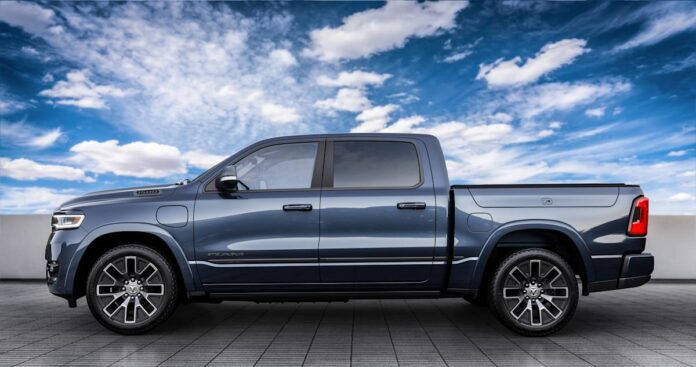Stellantis peeled back the curtain Feb. 24 on the 2026 Ramcharger and revealed some interesting stats on performance and fuel economy.
Ramcharger, you’ll remember, is the extended range version of the Ram 1500 that is powered by a 3.6-liter V-6 engine and a pair of electric motors driving the front and rear wheels. The 271-hp Pentastar engine is bolted to a generator that makes electricity for the two motors, and it charges the 91.8-kilowatt-hour lithium ion battery pack. Because there is no mechanical connection between the V-6 and the wheels, only the electric motors drive the truck.
Although there are hybrid pickups from Ford and Toyota, and full electric trucks from Rivian, General Motors and Ford, Ramcharger is the first pickup with a range extender powertrain.
It has the potential to throw a wrench into the established order.
Sign up for Automotive Views, Automotive News’ weekly showcase of opinions, insights, ideas and thought leadership.
The Ramcharger’s fuel economy
Diesel retains the fuel economy crown for drivers who want to go far on a gallon of fuel. For 2025, the Chevrolet Silverado 1500 remains the most fuel-efficient full-size pickup, with two-wheel-drive models sporting an eye-popping 33 mpg highway and a range of nearly 800 miles between fuel stops. The four-wheel-drive Silverado diesel, which compares better to the Ramcharger, is EPA-rated at 29 mpg highway and goes 696 miles on a tank — 6 miles more than the Ramcharger.
But for some pickup owners, diesel is a nonstarter. Not only is there diesel exhaust fluid to add, but diesel fuel is usually more expensive than gasoline. And repair costs on diesel engines can be wallet busters.
Rivian, Chevrolet and Ford electric pickup drivers have discovered their trucks work great — until you make them work. Connect up a trailer or fill the bed with sacks of cement and the range between charges melts away. And then there’s the often confusing miasma of dealing with public charging stations and waiting for the battery pack to charge.
Story continues
The Ramcharger is the truck that dodges diesel hassles and range anxiety. But it doesn’t deliver any fuel economy benefit over gasoline-powered competitors or even its stablemate, the standard six-cylinder four-wheel drive Ram 1500, which is rated at 17 city, 24 highway and 19 combined mpg. Stellantis said the Ramcharger’s expected fuel economy ratings are 60 mpg of gasoline equivalent and 20 mpg, but those numbers are likely for an unladen truck. And one other thing: The Ramcharger is not a lightweight. The truck weighs a whopping 7,507 pounds, partly because of the beefy steel frame needed to protect the battery pack and fuel tank.
Advantages and a question mark
One clear advantage the Ramcharger has over competitors is towing capacity. Stellantis said the truck can tow as much as 14,000 pounds. The F-150 Lightning’s highest towing capacity is 10,000 pounds, while the Rivian R1T can haul a maximum of 11,000 and the Chevrolet Silverado EV can drag a load weighing as high as 12,500.
The other advantage, of course, is that the Ramcharger will not be sidelined waiting for a plug at a public charger and it won’t be at the mercy of the charging grid. The average American gasoline pump spits out around 8 gallons per minute, meaning the Ramcharger’s 27-gallon fuel tank can usually be filled in under four minutes. The truck also can drive as far as 145 miles on electric power only.
Will the Ramcharger’s class-leading towing capacity and freedom from charging snafus be enough to make it a hit?
Here’s my prediction: If it has a six-figure price tag, it will be DOA. The driving experience is going to be unlike anything we’ve ever experienced in a truck and Ram’s reputation for outstanding interiors should bode well for the Ramcharger. But for the truck to get any significant traction in the market, it must be an incredible value. Ram brand CEO Tim Kuniskis said the sticker price will be announced closer to launch, which will be in the second half of the year.
Send us a letter to the editor
Have an opinion about this story? Tell us about it and we may publish it in print. Click here to submit a Letter to the Editor.


